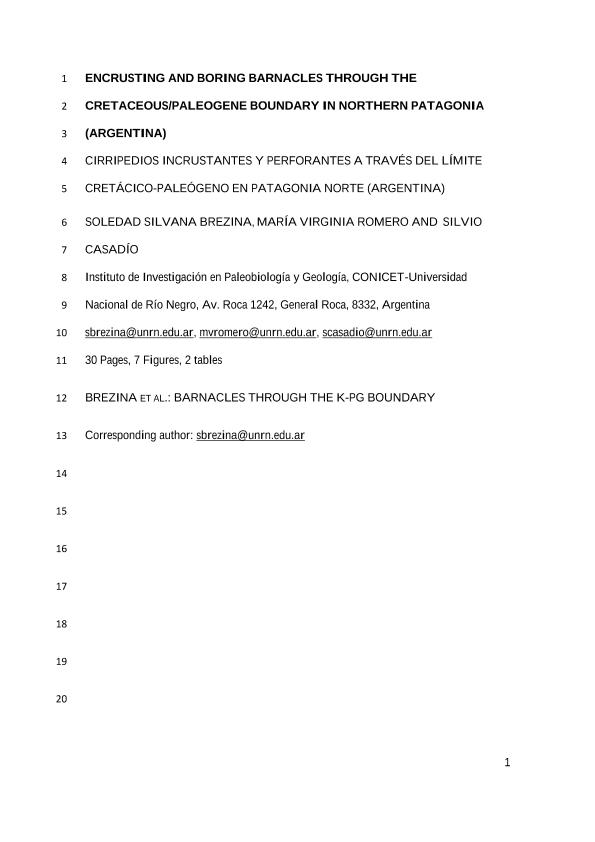Artículo
La información sobre cirripedios como componentes fósiles de las comunidades de substratos duros de latitudes medias en el Hemisferio Sur es escasa. Los cambios en estas comunidades durante episodios de extinción como el que ocurrió durante el límite Cretácico/ Paleógeno (K—Pg), son casi desconocidos. En este trabajo describimos los cirripedios incrustantes y perforantes asociados a ostras maastrichtianas y danianas, evaluamos los procesos tafonómicos involucrados, y registramos los cambios en su frecuencia de ocurrencia en el tiempo. Se estudiaron 1.174 valvas pertenecientes a nueve especies de ostras, recolectadas de las formaciones Jagüel y Roca de la Cuenca Neuquina. Se registró la presencia/ ausencia de los cirripedios o de sus trazas bioerosivas, se calcularon las frecuencias de incrustación y bioerosión y se realizaron análisis tafonómicos y estadísticos. Los cirripedios incrustantes identificados fueron asignados a Verruca rocana, y sus trazas asignadas a la icnoespecie Centrichnus concentricus Bromley y Martinell. Los cirripedios perforantes, están representados por trazas asignadas al icnogénero Rogerella. Los análisis tafonómicos indicaron que durante el Maastrichtiano tardío y Daniano temprano, las ostras muestran una condición intermedia a pobre para la abrasión y la fragmentación, mientras que las ostras del Daniano tardío exhibieron una condición bueña-regular o mixta para ambos atributos. Verruca rocana no muestra registros durante el Maastrichtiano tardío pero sí presenta alta frecuencia de incrustación de valvas luego del límite K—Pg. Los cirripedios perforantes presentaron una declinación en la abundancia durante el Daniano temprano y un aumento en el Daniano tardío. Ambos grupos presentaron un aumento en sus frecuencias durante el Daniano tardío. Information about barnacles as fossil components of hard substrate communities from middle latitudes in the Southern Hemisphere is scarce. Changes in these barnacle communities during episodes of extinction, such as that which occurred during the Cretaceous/Paleogene (K-Pg) boundary, are almost unknown. We describe encrusting and boring barnacles associated with Maastrichtian and Danian oysters, evaluate the involved taphonomic processes and report changes in their frequencies over time. A total of 1,174 valves belonging to nine oyster species, collected from the Jagüel and Roca formations of the Neuquén Basin, were analyzed. Presence/absence of barnacles or their bioerosional traces were recorded, frequencies of host incrustation and bioerosion were calculated and taphonomic and statistical analyses were performed. The encrusting barnacles identified on the oyster shells were assigned to Verruca rocana and, their traces, to the ichnospecies Centrichnus concentricus Bromley and Martinell. The boring barnacles are represented by traces assigned to the ichnogenus Rogerella. A preliminary taphonomic analysis indicated that late Maastrichtian and early Danian shells presented a fair-poor condition given by abrasion and fragmentation as taphonomic attributes while late Danian shells exhibited mostly good-fair or mixed condition for both attributes. Verruca rocana was not recorded during the late Maastrichtian but high frequencies of encrusted valves did become apparent after the K-Pg boundary. Boring barnacles represented by the trace Rogerella exhibited a decline in abundance during the early Danian but an increase during the late Danian. Both the encrusting and the boring barnacles associated with oysters presented an increase in their frequencies during the late Danian.
Encrusting and Boring Barnacles Through the Cretaceous/Paleogene Boundary in Northern Patagonia (Argentina)
Título:
Cirripedios incrustantes y perforantes a través del límite cretácico/paleógeno en Patagonia Norte (Argentina)
Fecha de publicación:
02/2017
Editorial:
Asociacion Paleontologica Argentina
Revista:
Ameghiniana
ISSN:
0002-7014
e-ISSN:
1851-8044
Idioma:
Inglés
Tipo de recurso:
Artículo publicado
Clasificación temática:
Resumen
Palabras clave:
Cirripedia
,
Hard Substrates
,
NeuquÉN Basin
,
Oysters
,
Sclerobionts
Archivos asociados
Licencia
Identificadores
Colecciones
Articulos(IIPG)
Articulos de INSTITUTO DE INVESTIGACION EN PALEOBIOLOGIA Y GEOLOGIA
Articulos de INSTITUTO DE INVESTIGACION EN PALEOBIOLOGIA Y GEOLOGIA
Citación
Brezina, Soledad Silvana; Romero, María Virginia; Casadio, Silvio Alberto; Encrusting and Boring Barnacles Through the Cretaceous/Paleogene Boundary in Northern Patagonia (Argentina); Asociacion Paleontologica Argentina; Ameghiniana; 54; 1; 2-2017; 107-123
Compartir
Altmétricas




